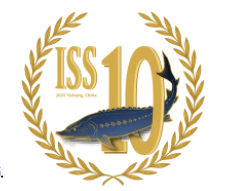Discovery of a genetic sex marker in sturgeon
Scientists have discovered a molecular marker for sex determination in sturgeon within the international project STURGEoNOMICS, led by IGB. This discovery represents a significant breakthrough for evolutionary biology, for species conservation and for caviar-producing aquaculture. This genetic evidence characterises the oldest known genetic sex-determining system in vertebrates with microscopically indistinguishable sex chromosomes. The short sex-specific DNA sequence, detected in several sturgeon species, can be traced back to a common sturgeon ancestor, 180 million years ago.
The international search for sex-linked genetic markers in sturgeon has been ongoing for decades. The discovery of this genetic element likewise provides evidence of the oldest known sex-determining system in vertebrates with undifferentiated sex chromosomes – evolved ca. 180 million years ago. Currently, ultrasonic diagnosis or biopsies are used for sexing sturgeon. For ultrasonic sexing to be reliable, however, sturgeons must reach progressed stages of maturation, which can take six to ten years in some species. Biopsies of the gonads are invasive, and stress or even harm the fish. In the future, the newly developed marker will enable scientists to differentiate between males and females simply by using a cotton skin swab to obtain DNA. Furthermore, the reliability of this test even outperforms the previous methods.
Use for species conservation
Many of the 27 sturgeon species occurring worldwide are highly endangered. In sturgeon conservation, the marker will be a good tool for the non-invasive sexing of fish, intended as future broodstock in reintroduction programs. “This enables a targeted selection of candidates for living gene banks, based not only on rare alleles, but also on sex. Fish not selected for broodstock development could then be reintroduced into the wild straight away,” evaluated Dr. Jörn Gessner, co-author of the study and coordinator the reintroduction program for native sturgeon of Germany at IGB.
More efficient aquaculture production of fish and caviar
In aquaculture production, the method could be used in the future for non-invasive early sexing of fish, intended for rearing. Production can then focus on rearing females for caviar and males for meat. As such, the test should by no means lead to the culling of male sturgeons, as the researchers explicitly stress. This ethical aspect is an essential element to be considered. “The next step will involve using the marker to develop a sex-determination test for practical application,” commented IGB researcher Heiner Kuhl, first author of the study.
Open questions about sexual development in the sturgeon
Sexual reproduction is an evolutionarily old feature of life. In vertebrates, sexual development is determined either by environmental triggers or by the genes, or sometimes a combination of the two. Most cold-blooded vertebrates, like fish and amphibians, do not have differentiated sex chromosomes, i.e. a microscopically distinguishable XX/XY system as in mammals or ZW/ZZ system as in birds. Sex chromosomes of many fish and amphibians can only be distinguished at the DNA level. There are several reasons for this: in most cases, a new master gene becomes the initial trigger for sex determination, even an evolutionary change of the sex chromosomes, in closely related species, is possible.
This study was accepted for publication by the Philosophical Transactions of the Royal Society B on 23 October, and will appear in a theme issue on sex chromosome evolution in spring 2021. A preprint is already available online.





